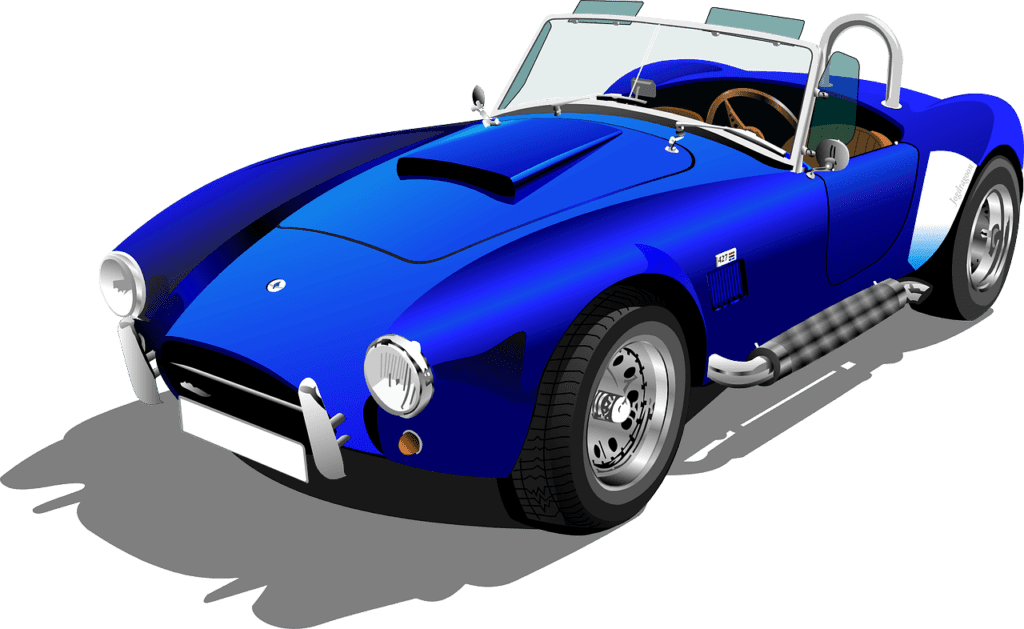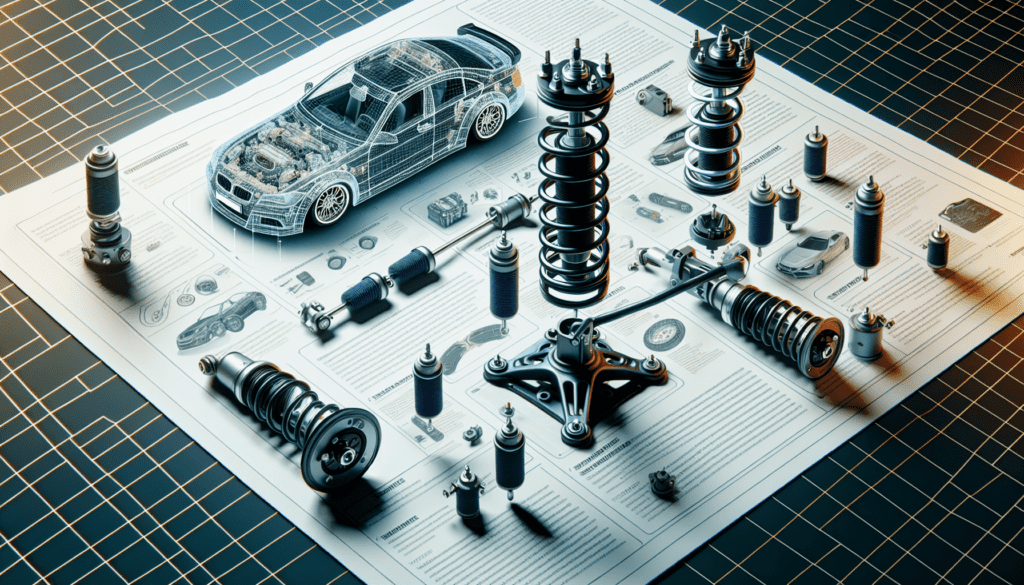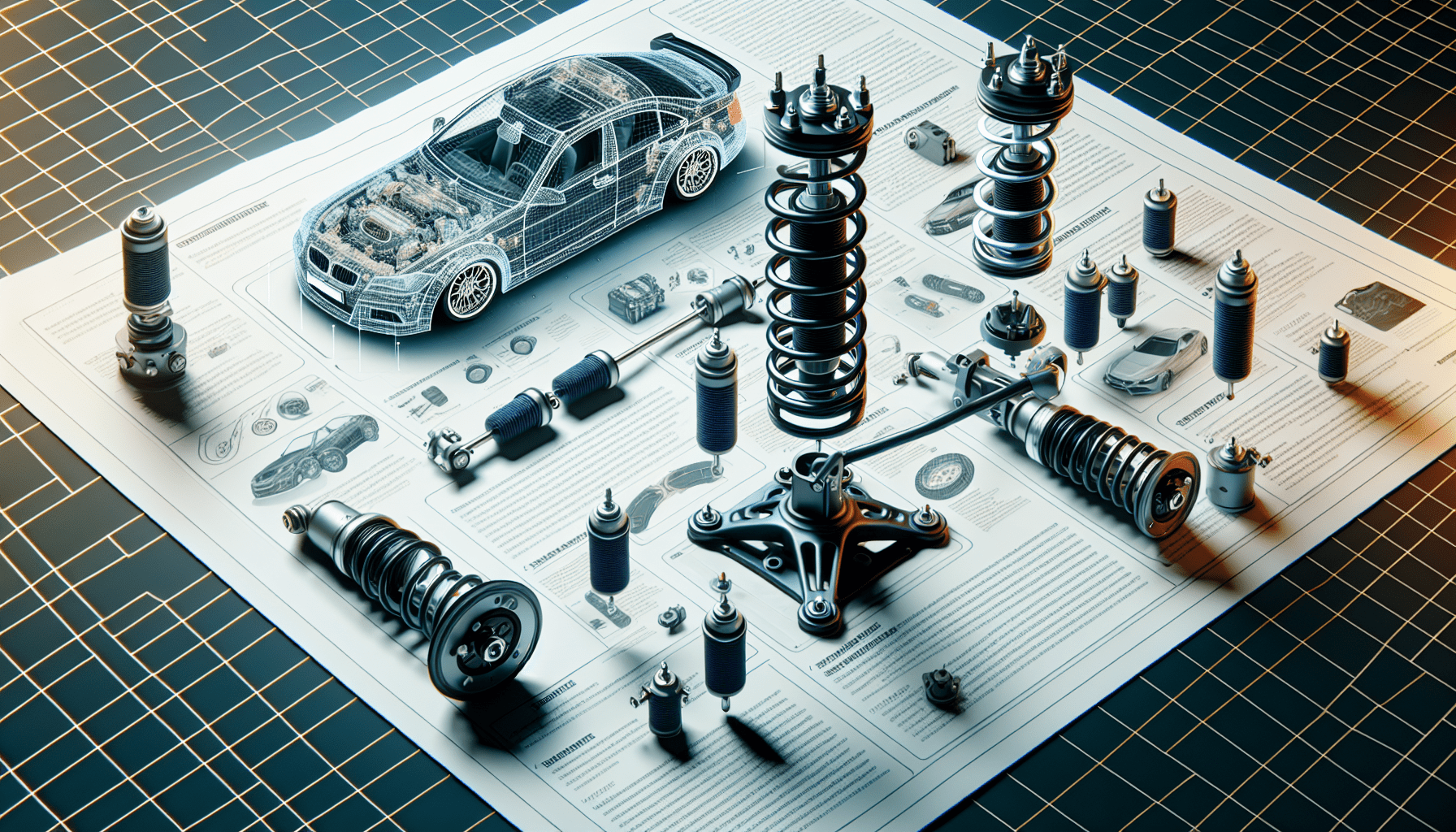Thinking about upgrading the suspension on your Ford Performance vehicle? Look no further! This article will serve as your guide to choosing the perfect suspension system that will enhance your driving experience and maximize the performance of your Ford. From understanding the different types of suspensions available to identifying your specific needs and preferences, we’ve got you covered. So, grab a cup of coffee and get ready to take your Ford Performance vehicle to the next level with the right suspension!

Understanding the Importance of Suspension
What is suspension?
When we talk about suspension, we are referring to the system that connects a vehicle’s wheels to its frame or body. The suspension plays a crucial role in ensuring a smooth and comfortable ride, as well as maximizing the performance and handling of your Ford performance vehicle. It is responsible for absorbing shocks and vibrations from the road, maintaining tire contact with the ground, and providing stability and control.
Why is suspension important for performance vehicles?
In performance vehicles, suspension is even more critical. The suspension system directly impacts how your vehicle handles, accelerates, and brakes. It affects the overall balance, traction, and stability, allowing you to push the limits of your Ford performance vehicle on both the street and the track. A well-tuned suspension can enhance cornering ability, reduce body roll, and improve overall responsiveness, giving you a more engaging and thrilling driving experience.
How does suspension affect vehicle handling and performance?
The suspension system has a direct impact on the vehicle’s handling and performance in several ways. Firstly, it controls body roll during cornering, keeping the car level and reducing the risk of understeer or oversteer. Secondly, it influences the vehicle’s traction, ensuring that the tires maintain optimal contact with the road surface for improved grip and control. Thirdly, the suspension affects the vehicle’s braking performance, allowing for more precise and consistent stopping distances. Ultimately, a properly tuned suspension can transform your Ford performance vehicle into a finely-tuned machine, delivering enhanced performance capabilities.
Types of Suspension Systems
Independent Suspension
Independent suspension is the most common type used in modern vehicles, including Ford performance vehicles. This system allows each wheel to move independently, providing better traction, improved handling, and a smoother ride. It offers increased stability during cornering and helps to minimize the impact of bumps and uneven road surfaces on the vehicle’s overall stability.
Solid Axle Suspension
Solid axle suspension, also known as live axle suspension, is a more traditional design commonly found in trucks and off-road vehicles. It uses a single beam axle that connects both wheels on an axle together. While solid axle suspension can offer excellent durability and off-road capability, it may compromise ride comfort and handling on paved roads due to its inherent stiffness.
Coil Spring Suspension
Coil spring suspension is the most prevalent type of suspension used in modern vehicles. It uses coil springs to absorb shocks and vibrations, providing a comfortable ride and good handling characteristics. Coil springs can be easily adjusted and fine-tuned to suit different driving styles and preferences, making them a popular choice for Ford performance vehicles.
Leaf Spring Suspension
Leaf spring suspension is commonly found in trucks and heavy-duty vehicles. It consists of multiple layers of metal strips curved into an arc shape. Leaf springs provide excellent load-carrying capacity and durability, making them ideal for towing and hauling applications. However, they can be less responsive in terms of handling and ride comfort compared to other suspension types.
Air Suspension
Air suspension is becoming increasingly popular in high-end performance vehicles, including some Ford models. It uses air-filled rubber bags or air springs instead of traditional coil or leaf springs. Air suspension allows for adjustable ride height, offering improved versatility and optimizing the vehicle’s aerodynamics. It can provide a plush and comfortable ride, while also offering the ability to stiffen the suspension for enhanced performance.
Considerations for Ford Performance Vehicles
Weight distribution and balance
When choosing a suspension system for your Ford performance vehicle, it is essential to consider the vehicle’s weight distribution and balance. Different suspension setups can help optimize weight transfer during acceleration, braking, and cornering, improving overall performance and handling characteristics.
Performance goals and driving style
Your personal performance goals and driving style should also influence your suspension choice. Are you primarily focused on track performance or street driving? Do you prefer a more aggressive and sporty setup, or do you value a comfortable ride for everyday use? Determining your priorities will help guide you towards the suspension system that best suits your needs.
Road conditions and usage
Consider the road conditions and usage that your Ford performance vehicle will encounter. Will you be primarily driving on smooth pavement or encountering rough and uneven surfaces? If you plan on taking your vehicle off-road, you may want to consider a suspension system specifically designed for rugged terrain.
Adjustability and customization options
Some suspension systems offer adjustability and customization options, allowing you to fine-tune the suspension to your preferences and specific driving conditions. If you desire the ability to make changes and adjustments to optimize your vehicle’s performance, it is worth considering suspension systems that offer this flexibility.
Compatibility with other aftermarket upgrades
If you plan on installing other aftermarket upgrades, such as larger wheels or performance brakes, it is crucial to ensure that the suspension system you choose is compatible with these modifications. Consider any potential limitations or additional modifications required to achieve the desired results.
OEM vs. Aftermarket Suspension
Benefits and drawbacks of OEM suspension
OEM suspension refers to the suspension system that comes standard from the factory with your Ford performance vehicle. The benefits of OEM suspension include compatibility and integration with other vehicle components, as well as the assurance of quality and reliability. However, OEM suspension may lack the customization and performance capabilities of aftermarket options.
Benefits and drawbacks of aftermarket suspension
Aftermarket suspension systems offer a wide range of options to suit different driving preferences and performance goals. They often provide more adjustability, improved handling, and enhanced performance compared to OEM suspension. However, it is crucial to ensure proper installation and compatibility, as aftermarket suspension systems may require additional modifications or professional expertise to achieve optimal results.
Cost considerations
Cost is an important factor to consider when choosing between OEM and aftermarket suspension. OEM suspension is generally less expensive, as it is included in the vehicle’s initial purchase price. Aftermarket suspension systems can range in price depending on the brand, features, and performance capabilities. It’s essential to consider your budget and weigh the cost against the desired benefits and improvements.
Warranty implications
Installing an aftermarket suspension system may have warranty implications. It is crucial to check with your vehicle manufacturer or dealership to determine any potential impact on your vehicle’s warranty. Some aftermarket suspension manufacturers may offer their warranties, providing peace of mind and protection for your investment.

Performance vs. Comfort
Balancing performance and comfort
Finding the right balance between performance and comfort is key when selecting a suspension system for your Ford performance vehicle. While a stiffer suspension may enhance handling and performance, it can also result in a harsh and uncomfortable ride. Conversely, a softer suspension may provide a smoother ride but could compromise performance and responsiveness. Determining your priorities and preferences will help you strike the right balance.
Adjustability and tuning for different needs
Many aftermarket suspension systems offer adjustability and tuning options. This versatility allows you to fine-tune your suspension to suit different driving conditions or personal preferences. Whether you prefer a more aggressive setup for spirited driving or a more relaxed setting for everyday comfort, the ability to make adjustments can significantly enhance your driving experience.
Understanding suspension stiffness
Suspension stiffness refers to the level of resistance the suspension system offers to movement. A stiffer suspension will resist body roll and weight transfer, providing a more responsive and controlled feel. However, a stiffer suspension may transmit more road imperfections and vibrations to the cabin. Finding the right balance of stiffness is crucial to strike a harmonious blend of performance and comfort.
Differences in shock absorbers and dampers
Shock absorbers and dampers play a critical role in controlling the movement of the suspension system. They help absorb shocks and vibrations from the road, allowing the suspension to provide a smooth and controlled ride. High-performance shock absorbers and dampers can offer improved damping characteristics, providing sharper handling and better control over the vehicle’s movements.
Factors to Consider When Choosing Suspension
Ride height and ground clearance
The ride height and ground clearance of your Ford performance vehicle can significantly impact its overall appearance, aerodynamics, and off-road capabilities. Some suspension systems offer adjustable ride height, allowing you to customize the vehicle’s stance to suit your preferences and specific driving conditions. Consider your desired ride height and ground clearance when choosing a suspension system.
Suspension geometry and alignment
The suspension geometry and alignment directly affect how the vehicle handles and performs. Proper suspension geometry ensures that the vehicle’s tires make optimal contact with the road surface, improving grip, stability, and responsiveness. It is important to choose a suspension system that aligns with your vehicle’s specific geometry requirements to maintain optimal performance.
Spring rates and sway bars
Spring rates determine the stiffness of the suspension springs. Higher spring rates provide a firmer suspension and better body control, ideal for aggressive driving and track usage. Lower spring rates offer a more comfortable ride suitable for daily driving. Sway bars, also known as anti-roll bars, control body roll during cornering. Consider the appropriate spring rates and sway bar options based on your desired balance of performance and comfort.
Damping and rebound control
Damping refers to the ability of the suspension system to absorb and control the energy from bumps and impacts. High-performance suspensions often offer adjustable damping settings, allowing you to fine-tune the suspension for different driving conditions. The rebound control influences how quickly the suspension returns to its normal position after compression. Balancing damping and rebound control can significantly affect the vehicle’s overall handling and ride characteristics.
Braking and handling characteristics
The suspension system plays a crucial role in the vehicle’s braking and handling characteristics. A properly tuned suspension can improve braking performance by maintaining optimal tire contact with the road surface, maximizing grip, and minimizing weight transfer. It provides stability and control during high-speed maneuvers, reducing body roll and improving overall handling precision.

Compatibility and Installation
Compatibility with factory components
When choosing a suspension system, ensure that it is compatible with your Ford performance vehicle’s factory components. Consider factors such as mounting points, wheel arch clearance, and connection points. Compatibility ensures a straightforward installation process and optimal performance.
Modification requirements
Depending on the suspension system you choose, there may be additional modifications required to your Ford performance vehicle. These modifications may include installing new control arms, sway bars, or adjusting the brake lines. It is important to plan and budget for any necessary modifications to ensure proper fit and performance.
Installation process and expertise
The installation process varies depending on the complexity of the suspension system and your technical expertise. Some suspension systems may require professional installation due to their complexity or compatibility requirements. If you’re uncertain about your abilities or lack the necessary tools and equipment, it’s best to seek professional assistance to ensure a proper and safe installation.
Professional assistance vs. DIY installation
Deciding whether to seek professional assistance or opt for a DIY installation depends on your comfort level, technical skills, and available resources. Professional assistance guarantees expertise and ensures proper installation. DIY installation can be a rewarding experience, but it requires a thorough understanding of the suspension system’s installation process and the necessary tools and equipment.
Researching and Comparing Suspension Options
Reviewing manufacturer specifications and details
Researching and comparing suspension options involves reviewing manufacturer specifications and details. Pay attention to factors such as materials used, construction quality, adjustability features, and performance capabilities. Reviewing the manufacturer’s reputation and customer feedback can provide valuable insights into the reliability and performance of the suspension system.
Reading customer reviews and feedback
Customer reviews and feedback offer real-world experiences and perspectives on different suspension systems. Reading reviews can provide insights into the pros and cons, performance characteristics, and overall satisfaction of other Ford performance vehicle owners who have installed the suspension system you are considering.
Consulting with automotive experts and enthusiasts
Consulting with automotive experts and enthusiasts can provide valuable advice and recommendations based on their experience and expertise. Enthusiast forums, online communities, and local performance shops are great resources to tap into for guidance and insights into the specific suspension systems you are considering.
Considering budget and value for money
Budget is an important consideration when choosing a suspension system. Determine your budget and research suspension systems within that range. Consider the overall value for money by weighing the features, adjustability, and performance benefits against the cost. Quality and reliability should also be factored into your budget considerations to ensure a worthwhile investment.

Seeking Professional Advice
Benefits of consulting with suspension specialists
Consulting with suspension specialists can provide detailed guidance tailored to your specific Ford performance vehicle. Suspension specialists have in-depth knowledge and experience with suspension systems and can help you navigate the various options available. They can provide expert advice to ensure the suspension system you choose meets your performance goals and preferences.
Local automotive performance shops and dealerships
Local automotive performance shops and dealerships often have knowledgeable staff who specialize in aftermarket suspension systems. They can offer insights into the best suspension options for your Ford performance vehicle and provide assistance with installation and any necessary modifications. Establishing a relationship with a trusted local specialist ensures ongoing support and guidance.
Understanding technical jargon and terminology
Navigating through the technical jargon and terminology associated with suspension systems can be overwhelming. Seeking professional advice can help you understand and interpret the specific terminology used in the suspension industry, ensuring that you choose the right system for your needs and preferences.
Getting a professional assessment and recommendation
A professional assessment and recommendation can provide peace of mind and confidence in your suspension system choice. Suspension specialists can assess your Ford performance vehicle’s current suspension setup, driving needs, and performance goals to recommend the system that will provide the best results. Their expertise ensures that you make an informed decision that aligns with your specific requirements.
Budget and Long-Term Considerations
Setting a realistic budget for suspension upgrades
Setting a realistic budget is crucial when considering suspension upgrades. Take into account the cost of the suspension system, potential modifications, installation, and any other associated expenses. It is important to balance your budget with the desired performance improvements and long-term value.
Considering maintenance and replacement costs
Maintenance and replacement costs should be factored into your budget and long-term considerations. Suspension systems require regular maintenance to ensure optimal performance and longevity. Additionally, certain components may need replacement over time due to wear and tear. Understanding the maintenance and replacement costs associated with your chosen suspension system is essential for long-term planning.
Long-term impacts on vehicle performance and value
Choosing the right suspension system can have long-term impacts on your Ford performance vehicle’s performance and value. A well-suited suspension system that improves performance and handling can enhance your driving experience, satisfaction, and enjoyment. It can also add value to your vehicle should you decide to sell or trade it in the future.
Resale implications and market preferences
While upgrading the suspension system can enhance your Ford performance vehicle’s performance, it is important to consider the potential resale implications and market preferences. Some buyers may prefer a stock suspension setup, while others may appreciate the added performance benefits of an upgraded suspension. Balancing personal preferences with potential resale value is essential for a well-rounded decision.
In conclusion, choosing the right suspension for your Ford performance vehicle requires careful consideration of factors such as suspension type, performance goals, driving style, road conditions, adjustability, and compatibility. It is important to strike a balance between performance and comfort, understanding the influence of suspension stiffness, damping characteristics, and alignment. Researching, comparing, and seeking professional advice can help you make an informed decision that aligns with your budget, long-term considerations, and desired driving experience. Remember, a properly chosen and installed suspension system can enhance your Ford performance vehicle’s performance, handling, and overall driving enjoyment.



